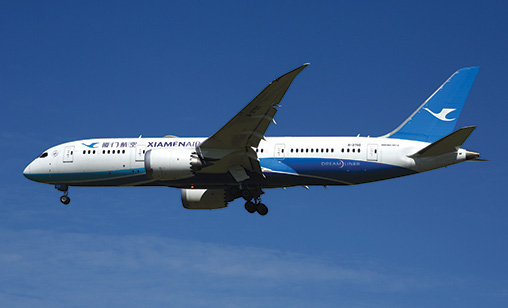News Backgrounder
First casualty of Trump’s trade war?
November 1st 2018
While Boeing Commercial Aircraft vice president marketing, Randy Tinseth, was briefing media on the sidelines of the Association of Asia-Pacific Airlines (AAPA) Assembly of Presidents in Jeju last month, word spread fast that an exclusive operator of Boeing aircraft, Xiamen Airlines, was talking to Airbus about potential orders. Read More »
 |
At press time there was no news of a change of airframe manufacturer at the Fujian province carrier nor had tariffs been imposed on U.S. jets by China. But the rumour crystalized a fear that U.S. President Donald Trump’s intensifying trade war with Beijing could encourage Chinese airlines to turn to Airbus for more of the huge number of aircraft they will need to accommodate forecast passenger demand.
Tinseth said in Jeju: “We’re in that place where we’re talking to both sides. We’re telling our story of fair and free trade and how important that is. We’re working closely with our customers and continue to deliver a lot of airplanes to our Chinese customers.”
Boeing forecasts the Chinese market will need 7,600 new aircraft, at a value of US$1.2 trillion, in the next two decades. Mainland airlines accounted for about 13% of the U. S. manufacturer’s revenue last year. It also is the company’s largest market for the B737, Boeing Commercial Airplanes’ biggest source of profit. In 2017, Boeing delivered 202 aircraft to Chinese airlines, compared with 176 by Airbus.
In December, Boeing’s joint venture Zhoushan completion centre will open on schedule. It is the aircraft manufacturer’s first such facility outside the U.S and has been developed with the state-owned Commercial Aircraft Corp. of China Ltd. It will employ local workers to paint and finish the interiors of single-aisle B737s. “We’re opening that in December. That has not changed,” said Tinseth.
Elsewhere, Boeing is pushing ahead with its latest wide-body, the B777X. It has sold 340 of the aircraft, including 21 to Cathay Pacific Airways and 20 each to All Nippon Airways and Singapore Airlines.
“The B777-300ER has become the best-selling version of the B777. It came to market in 2004. That plane will commence its replacement cycle early next decade. That is when we are going to be in a really good place and where it is going to be really good news for the 777X,” said Tinseth.
 |
Work is continuing on the development of a mid-market aircraft (NMA), which will require board approval. “A decision is expected sometime next year. It’s not only about what your customers want. You have to identify the right airplane configuration and accurate development costs. Even more importantly, it must be a viable product with costs below the price,” he said.
Tinseth questioned reports Airbus would beat the NMA to the market with it’s an ultra-long-range A321. He said the A321 is a great airplane - Airbus has sold about 1900 of the type – but the long range version is a niche market.
“You pay a dear cost. When you add take-off weight a cost is associated with that and I think it means it will continue be a niche market [for the aircraft]. The mid-market plane is longer range and bigger. It is not a single-aisle airplane nor is it a wide-body airplane. It’s something in between. Again, we are working for a different opportunity which is something you can’t address today.”
Tinseth said Boeing believed the MAX 10 was the competitor to the A321. They are essentially the same size. “It has the ability to fly on any route an NG does today and has great economics. It’s a stretch so the economics are compelling. We launched it a little over a year ago and we’ve sold 500 plus of these units. So, we are doing OK.”
As for the growing number of ultra-long-haul services being inaugurated by airlines, including Singapore Airlines’ recent launch to New York with an Airbus A350, Tinseth said: “They could do it in our aircraft and make more money.”
“You can always trade payload for range. There’s nothing magic. You can take a B787-9, configure it in the same way and have 5% lower trip costs. The plane is lighter and more fuel efficient.
“You have to dedicate yourself to a special configuration that has costs associated with it. Ultra-long haul works when you can take an airplane in standard configuration and make it work with a full load. It also is important that you have a strong business class mix. SIA has to have three aircraft – worth approximately $600 million - dedicated to a single route on long range flights where the percentage of fuel to costs is greater.”